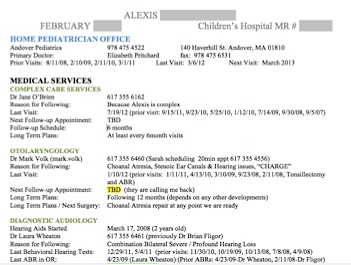How to Stay Organized when Raising a Special Needs Child

“How are you doing?”
If you’re the parent of a child with medical complexities your answer is probably, “Stressed.”
According to a study on stress and memory, stress can affect how we learn, how we consolidate memories and how we retrieve information from our brains. So what can we do to handle the multiple diagnoses and never-ending stream of medical information about our children? I can’t answer that for everyone, but I can share what works for me.
My daughter Alexis is followed by eighteen different specialists at our local Children’s Hospital, including Complex Care Service dedicated specifically for children who are medically complex. She is undiagnosed genetically, but presents similar to children with CHARGE Syndrome with an anomaly in almost every single organ system.
With eighteen different specialists, we have had numerous occasions to explain to each one of these doctors how Alexis is doing with her other doctors. Ironically, the longest sequence a normal person can recall immediately on average is seven items (you can read about that here). So how are parents supposed to remember eighteen sets of diagnoses, charts, tests and follow ups?
Creating a Simple Medical Document
I realized quickly that I was not going to be able to remember everything. I set out to create something that was intuitive to share with Alexis’ entire team; Something that is basic, easy to maintain, flexible and full of content.
The document that I created includes essential information about Alexis and her needs. This would obviously vary from child to child, but here is the basic outline for our document:

- Doctor Information
Doctor, Phone number, email
Past and Future appointments
Brief Summary of last appointment
- Equipment/Medical Supply
Medication or Equipment
Ordering Frequency
Phone, Fax information
- Educational Services
Service Delivery Grid from IEP
Additional Therapies (outside of school)
- A Recent Photo
- Feeding Schedule
Some Practical Tips
- It doesn’t have to be perfect. This will always be a working document to add more information to.
- I organize the list of doctors by either frequency of visits or urgency of care.
- Keep it in your own words. It should reflect the crucial information you interpret from your visits.
- Add a photo. Seeing your child on the page will help doctors and nurses remember that they are dealing with a real person.
- Use color codes. Color can bring things to life and highlight how things are related or what’s important. For example, you might use a yellow highlight for information that you need to follow up on (like that test or appointment that you still need to schedule) or use the same color font for all the doctors you see at one hospital.
I share this widely with Alexis’ extended team—her doctors, her IEP team, her therapists outside of school, her out of town family, her current PCAs and her potential PCAs. Her Complex Care Service doctor loves it so much he places a copy every six months into the Hospital’s Medical Record. He has previously said it’s the most intuitive summary of Alexis!
Now when people ask, “How are you?” I say, “Organized!” Will you join me?
Some Resources
If you don’t want to start from scratch, you can download blank versions of this document. You can choose between a PDF file (which you can print and fill out) or a Word Doc (which you can edit and rearrange).
You can also create a simpler Quick View version of your child’s medical records that fits all on one page. This version may be better when you are talking to a nurse or intern and just want to make sure they understand some basic information about your child.
Learn more about Catherine Rose.
Related Posts

Special Needs
What Age is Appropriate for Babysitting a Sibling with Special Needs?
Careful planning is needed to determine if your children can babysit their siblings with special needs. Find out more in this guide.

Special Needs
Adjusting to Daylight Saving Time: A Guide for Parents of Children with Special Needs
Time changes can be hard for kids. Learn tips and tricks for adjusting to daylight saving time to help ease the transition for children with special needs.

Holiday Crafts and Ideas, Special Needs
5 Tips for a Peaceful Thanksgiving with Your Child with Disabilities
Thanksgiving can be a joyful yet overwhelming holiday, especially for families with children who have sensory, motor, or dietary needs. With a little preparation and a few practical strategies, you...